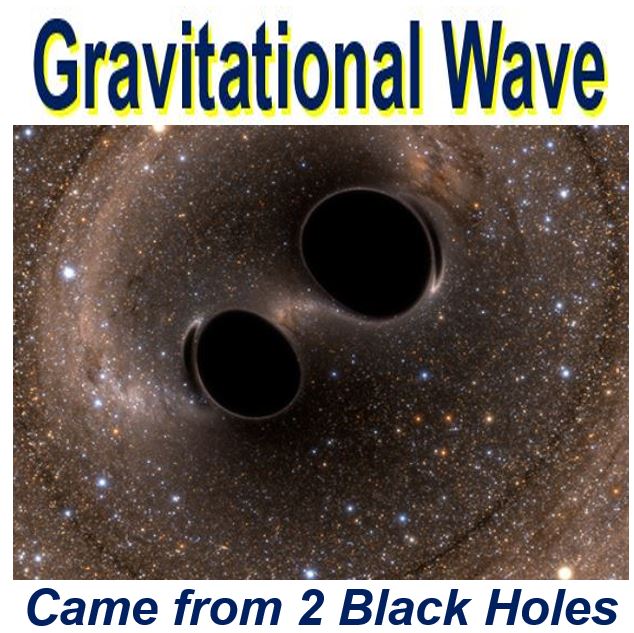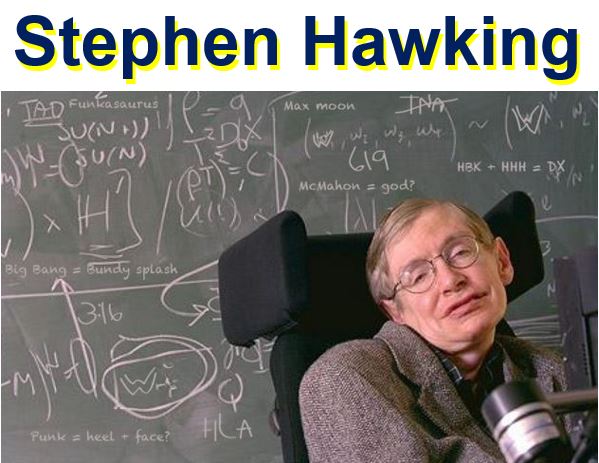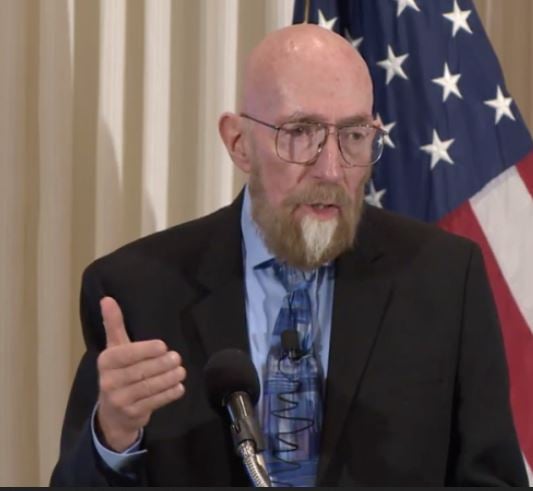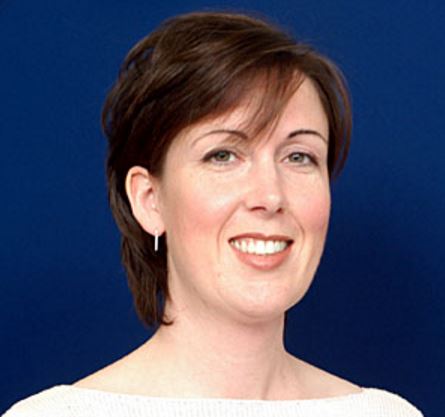Britons were among the Special Breakthrough Prize in Fundamental Physics winners, the Prize’s Selection Committee announced yesterday. The Committee has awarded a Special Breakthrough Prize in Fundamental Physics for the scientists and engineers who contributed to the momentous detection of gravitational waves, a breakthrough that was announced on 11th February 2016.
The Special Breakthrough Prize is conferred at any time when an extraordinary scientific achievement is acknowledged.
 The gravitational wave that was detected came from two black holes colliding. According to NASA: “A passing gravitational wave squishes and stretches – squishes and stretches space itself and anything in it.” (Image: ligo.caltech.edu)
The gravitational wave that was detected came from two black holes colliding. According to NASA: “A passing gravitational wave squishes and stretches – squishes and stretches space itself and anything in it.” (Image: ligo.caltech.edu)
Two groups to share award
The award, totaling $3 million (£2.06m) will be shared between two groups of laureates:
– First Group: the 3 founders of LIGO (Laser Interferometer Gravitational-Wave Observatory) – they will get one-third of one million dollars each. They are Rainer Weiss, MIT, professor of physics, emeritus; Kip S. Thorne, Caltech, the Feynman Professor of Theoretical Physics, emeritus; and Ronald W. P. Drever, Caltech, professor of physics, emeritus.
– Second Group: the 1,012 contributors to the experiment, who will share $2 million. They include the 1,005 authors of the paper describing the discovery of gravitational waves from several institutions involved in LIGO and its sister experiment, the Virgo collaboration.
The University of Glasgow in Scotland said that some of its scientists are included within that pool of 1,012 contributors – they will receive approximately $2,000 (£1,350) each. The university informed in February this year how some scientists from its Institute for Gravitational Research led on the development, construction and installation of the sensitive ‘mirror suspension’ within the LIGO detectors.
 Selection Committee member Prof. Stephen Hawking, who described the detection of a gravitational wave as an ‘incredible achievement’, believes this was the first of several exciting findings to come. (Image: hawking.org.uk)
Selection Committee member Prof. Stephen Hawking, who described the detection of a gravitational wave as an ‘incredible achievement’, believes this was the first of several exciting findings to come. (Image: hawking.org.uk)
University of Glasgow scientists had worked alongside their counterparts from the Universities of Birmingham and Strathclyde, as well as the STFC Rutherford Appleton Laboratory in Oxfordshire.
Seven scientists are also among the 1,012 collaborators – they made key contributions to LIGO’s success. They are Luc Blanchet, CNRS (Centre National de la Recherche Scientifique · Institut d’Astrophysique de Paris), France; Mark Scheel, Caltech, USA; Frans Pretorius, Princeton University, USA; Thibault Damour, IHES (Institut des Hautes Études Scientifiques), France; Lawrence Kidder, Cornell University, USA; Saul A. Teukolsky, Cornell University, USA; and Rochus E. Vogt, Caltech, USA.
The prize-winners will be recognized at the 2017 Breakthrough Prize ceremony in the autumn of 2016, where the yearly Breakthrough Prize in Fundamental Physics (not the same as the ‘special’ prize) will also be presented, along with the Breakthrough Prizes in Life Sciences and Mathematics.
Gravitational wave detection – Huge breakthrough
Professor Stephen Hawking, a Special Breakthrough Prize winner in 2013, said:
“This discovery has huge significance: firstly, as evidence for general relativity and its predictions of black hole interactions, and secondly as the beginning of a new astronomy that will reveal the universe through a different medium. The LIGO team richly deserves the Special Breakthrough Prize.”
 Kip Thorne, a co-founder of LIGO, once said: “Gravitational waves will bring us exquisitely accurate maps of black holes – maps of their space-time. Those maps will make it crystal clear whether or not what we’re dealing with are black holes as described by general relativity.” (Image: media.tumblr.com)
Kip Thorne, a co-founder of LIGO, once said: “Gravitational waves will bring us exquisitely accurate maps of black holes – maps of their space-time. Those maps will make it crystal clear whether or not what we’re dealing with are black holes as described by general relativity.” (Image: media.tumblr.com)
A co-founder of the Breakthrough Prizes, Yuri Milner, said:
“The creative powers of a unique genius, many great scientists, and the universe itself, have come together to make a perfect science story.”
Chair of the Selection Committee, Edward Witten, commented:
“This amazing achievement lets us observe for the first time some of the remarkable workings of Einstein’s theory. Theoretical ideas about black holes which were close to being science fiction when I was a student are now reality.”
 Professor Sheila Rowan, director of Glasgow University’s Institute for Gravitational Research, said: “I’m absolutely delighted that the 2016 Special Breakthrough Prize in Fundamental Physics has been awarded for the observation of gravitational waves, and in particular that the committee chose specifically to share part of the prize amongst all the scientists and engineers who contributed to the discovery – the success of the field is built on the contributions of many people and it’s terrific to see the whole Ligo team recognised.” (Image: physics.gla.ac.uk)
Professor Sheila Rowan, director of Glasgow University’s Institute for Gravitational Research, said: “I’m absolutely delighted that the 2016 Special Breakthrough Prize in Fundamental Physics has been awarded for the observation of gravitational waves, and in particular that the committee chose specifically to share part of the prize amongst all the scientists and engineers who contributed to the discovery – the success of the field is built on the contributions of many people and it’s terrific to see the whole Ligo team recognised.” (Image: physics.gla.ac.uk)
What is LIGO?
The notion and R&D of LIGO’s gravitational wave detectors started in the 1960s. It was built by MIT and Caltech in partnership with the NSF (National Science Foundation) between 1994 and 2002. The aim was to observe the gravitational waves that Albert Einstein had predicted in his General Theory of Relativity.
LIGO underwent a major upgrade from 2010 to 2015, after which it nearly immediately observed a gravitational wave distorting the structure of spacetime as it passed through our planet.
The detected distortion was ultra-tiny – less than a billionth of a billionth of a metre in size – at LIGO’s two 4km (2.5 miles) observatories in Livingston, Louisiana and Hanford, Washington.
The wave had come from two black holes, which had masses approximately thirty times that of our Sun, spiraling into each other 1.3 billion light years from here.
According to breakthroughprize.org:
“The discovery inaugurates a new era of gravitational wave astronomy which will open a window onto some of the most dramatic and violent phenomena in nature as well as the mysteries of the early Universe.”
What is the Special Breakthrough Prize in Fundamental Physics?
The Selection Committee may award a Special Breakthrough Prize in Fundamental Physics at any time, in addition to the Breakthrough Prize conferred through the ordinary yearly nomination process.
Previous winners of the Special Breakthrough Prize in Fundamental Physics include seven leaders of the LHC (Large Hadron Collider) teams that discovered the Higgs Boson.
This year’s Selection Committee for the ‘Special’ prize included the following members: Lyn Evans, Nima Arkani-Hamed, Michael B. Green, Alan Guth, Saul Perlmutter, Alexander Polyakov, Stephen Hawking, Joseph Incandela, Takaaki Kajita, Alexei Kitaev, Maxim Kontsevich, Andrei Linde, Adam Riess, John H. Schwarz, Arthur McDonald, Juan Maldacena, Nathan Seiberg, Yifang Wang, Ashoke Sen, and Edward Witten.
What is the Breakthrough Prize in Fundamental Physics?
The Breakthrough Prize in Fundamental Physics recognises individual scientists who have made ‘profound contributions to human knowledge’.
It is open to all physicists – experimental, mathematical and theoretical – working in the deepest mysteries of our Universe. The prize may be given to one person or shared among a number of scientists.
Both prizes are funded by a grant from the Milner Global Foundation.
Video – What are gravitational waves?
In this video, physicists Umberto Cannella and Daniel Whiteson explain what gravitational waves are in an easy way to understand for lay people.
